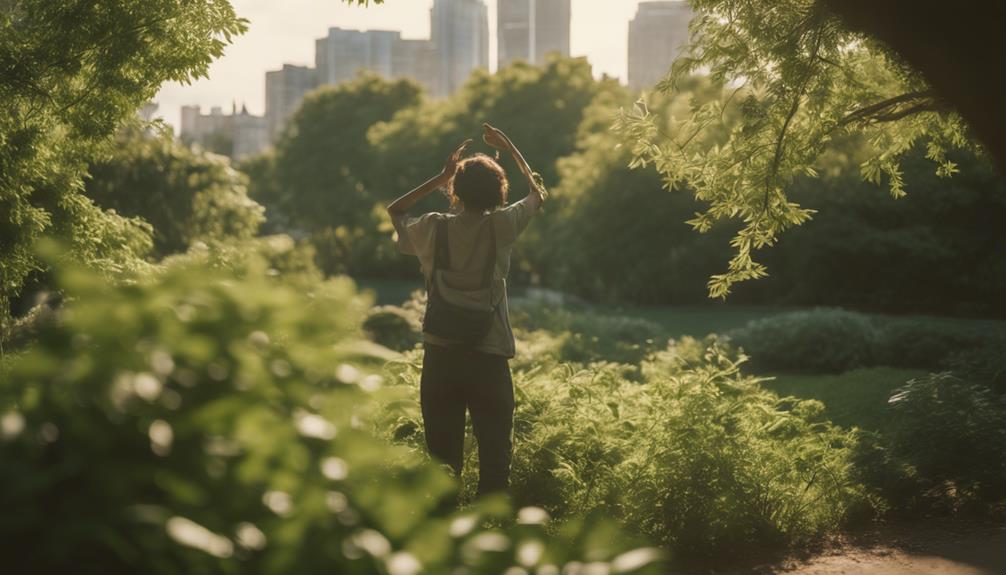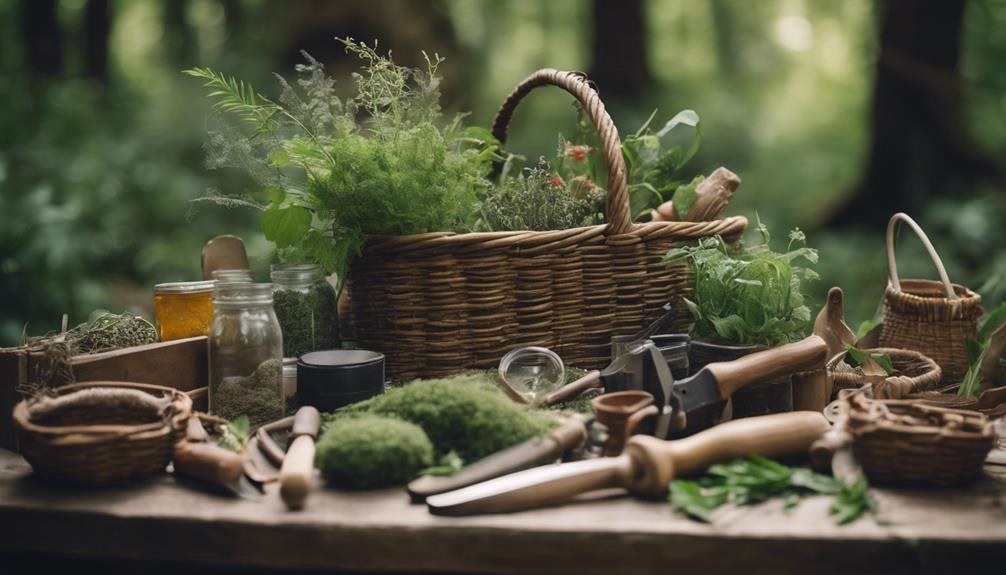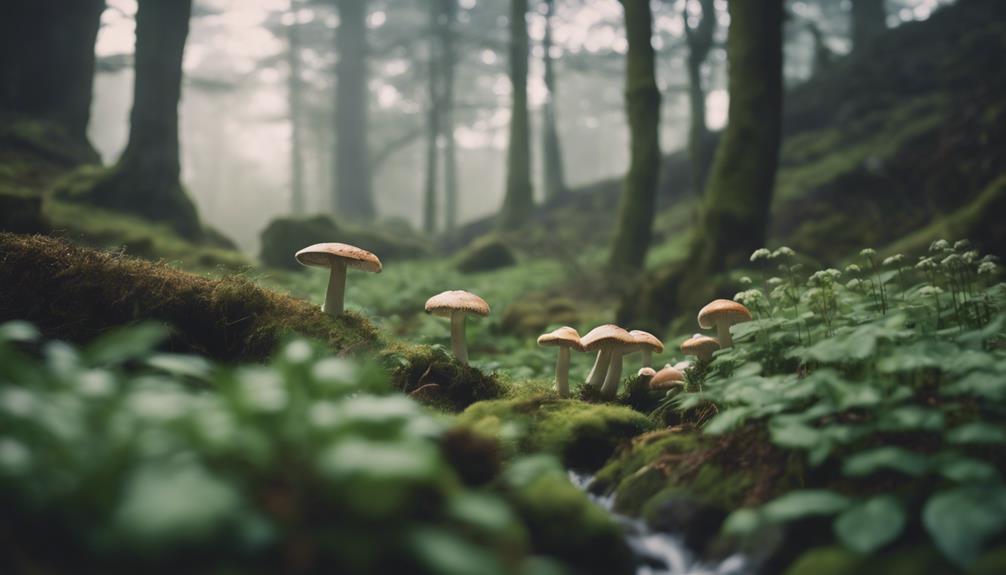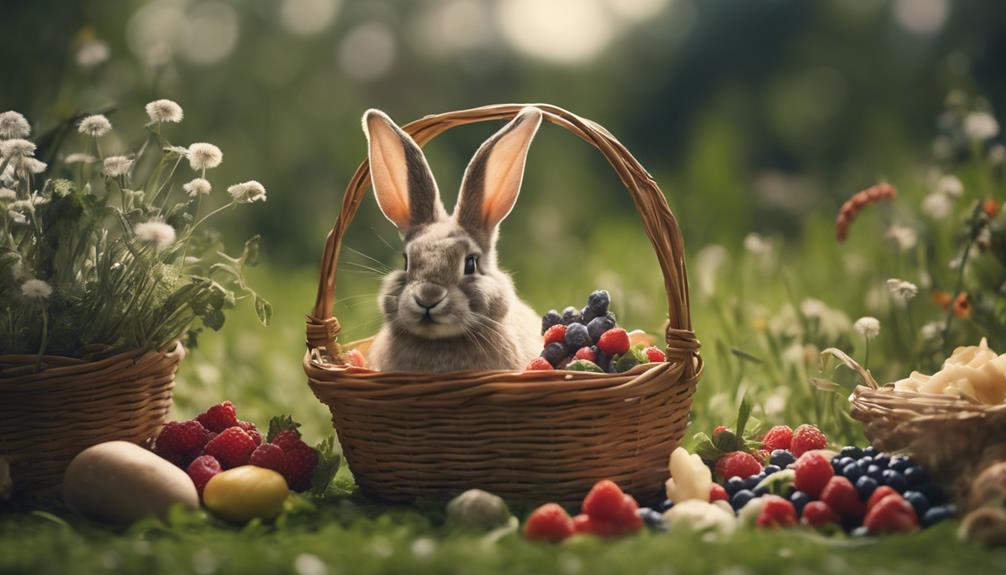Understanding the dos and don'ts of urban foraging is crucial before you start exploring the abundance of wild edibles in urban parks. Identifying edible plants correctly, avoiding contaminated areas, and respecting park regulations and wildlife habitats are all important aspects to consider. Urban foraging can offer a fulfilling experience, encouraging sustainability and a closer connection with nature, but it necessitates responsible practices. By familiarizing yourself with the guidelines and ethics, you can delight in the offerings of urban parks while also preserving the environment. Keep on delving into the realm of urban foraging and uncovering its mysteries.
Key Takeaways
- Urban parks can be valuable sources of wild edibles, but it's essential to understand the park's regulations and guidelines before foraging.
- Correct identification of edible plants is crucial to avoid mistakenly consuming poisonous lookalikes, and research or guided tours can help ensure safe foraging.
- Respecting private property boundaries, obtaining permission, and following local regulations are vital for ethical and responsible urban foraging practices.
- It's important to harvest sustainably, minimizing impact on the ecosystem, and leaving no trace to preserve the environment and wildlife habitats.
- Ignoring park guidelines and foraging without permission can result in legal consequences, fines, and damage to the environment and wildlife habitats.
Urban Foraging 101
As you venture into urban foraging, you'll quickly discover that many parks are treasure troves of wild edibles, from juicy berries to crunchy greens and nutritious nuts.
Urban foraging in parks is an excellent way to connect with nature and gather fresh, organic foods. Many parks offer a variety of edible plants, making them ideal locations for urban foraging.
By foraging in parks, you're not only getting free food, but you're also promoting sustainability by utilizing local resources and reducing food waste. With proper knowledge and respect for park regulations, urban foraging can be a rewarding and educational experience.
You'll learn about the different types of edible plants, how to identify them, and how to harvest them sustainably. Urban foraging 101 is all about understanding the basics of foraging in urban areas, and parks are a great place to start.
Finding Edible Plants Safely

When venturing into a park to forage for edible plants, you'll want to keep a sharp eye out for common species like dandelions, chickweed, and plantain, while avoiding areas that may be contaminated with pollutants or pesticides.
To guarantee a safe and successful urban foraging experience, remember:
- Look for diverse edible plants, including berries, nuts, and herbs, like blackberries, acorns, and mint.
- Avoid areas near roadsides, dog parks, or heavily trafficked paths where plants may be contaminated.
- Be cautious of poisonous lookalikes and only harvest plants you can positively identify to secure safe foraging.
- Respect park regulations and wildlife habitats while foraging, leaving areas undisturbed and taking only what you need.
- Identify plants correctly to secure you're foraging for edible plants, not poisonous ones.
Parks and Wild Edibles Overview

As you explore urban foraging, you'll find that parks offer a treasure trove of wild edibles, from herbs to berries, nuts, and greens.
Before you start foraging, it's essential to identify permitted areas and understand urban park regulations, ensuring you're aware of what's allowed and what's not.
Permitted Foraging Areas
Many urban parks offer a treasure trove of wild edibles, and you can forage for them legally, provided you follow the rules. Urban parks can be rich foraging grounds for edible plants like dandelions, berries, and herbs.
To guarantee a successful and sustainable foraging experience, it's crucial to research the park's guidelines and regulations.
Here are some key considerations to keep in mind:
- Check local park regulations to make certain foraging is permitted and follow guidelines for sustainable harvesting.
- Respect designated areas for foraging, if specified.
- Research the park's wild edibles and connect with nature by exploring the diverse range of plant species.
- Familiarize yourself with park regulations to avoid any misunderstandings.
- Always prioritize sustainable harvesting to preserve the park's ecosystem.
Urban Park Regulations
You'll need to familiarize yourself with the specific regulations governing urban park foraging in your area, as rules vary widely from one park to another. Urban park regulations regarding foraging in parks can be complex, and it's important to understand the park rules before you head out to forage. Some parks have designated foraging areas, while others may require permits for foraging or restrict certain activities to protect the ecosystem and preserve wildlife habitats.
Before you start foraging, check with local authorities or park management to understand any specific regulations or restrictions in place. This is necessary to make sure that you're respecting park guidelines and not harming the environment.
Urban parks can offer a diverse range of edible plants, including fruits, berries, nuts, and herbs, but it's vital to prioritize the protection of the ecosystem. By understanding and respecting urban park regulations, you can enjoy the benefits of foraging in parks while also preserving the natural environment.
Wild Edible Abundance
Frequently, urban parks surprise visitors with an abundance of wild edibles, offering a diverse range of fruits, nuts, and herbs waiting to be discovered. As you explore these urban foraging grounds, you'll find a variety of edible plants and fruits, providing a convenient source of free food.
Some common wild edibles you might find in parks include:
- Blackberries and mulberries growing wild
- Fresh mint and plantain leaves for teas and salads
- Dandelions for salads and coffee substitutes
- Nuts like walnuts and hazelnuts for snacking
- Wild herbs like chamomile and lemon balm for teas and potpourri
For beginners, urban parks offer an ideal environment to start foraging, with diverse plant species and relative safety from pollution.
As you forage, you'll connect with nature and discover an abundance of nutrient-rich foods. So, next time you visit a park, keep an eye out for these wild edibles and start enjoying the bounty of urban foraging!
Urban Foraging Ethics Matter

Respecting private property boundaries and obtaining permission before foraging in parks is vital to urban foraging ethics, as it helps maintain a positive relationship with landowners and guarantees a continued foraging experience.
You must understand that ethical foraging practices involve leaving no trace, minimizing impact on the environment, and only taking what you need.
When foraging in public parks and green spaces, it's important to follow local regulations and restrictions to guarantee responsible foraging. This not only helps preserve the environment but also promotes community engagement and environmental awareness.
By adopting sustainable foraging practices, you'll be sharing knowledge and experiences with other foragers, fostering a harmonious relationship with nature.
Remember, practicing ethical gathering protects wildlife habitats, preserves ecosystems, and promotes a healthy coexistence with nature.
As you forage, keep in mind that your actions have a direct impact on the environment, and it's your responsibility to minimize that impact. By doing so, you'll be contributing to a more sustainable and environmentally conscious community.
Harvesting and Preparing Finds

As you've mastered the art of ethical foraging, it's time to focus on harvesting and preparing your finds, making sure that the wild edibles you've collected are safe to eat and bursting with flavor. Now that you've identified the perfect plants, it's important to handle them properly to avoid contamination and guarantee a delicious meal.
When harvesting and preparing your foraged foods, remember:
- Wash your finds thoroughly to remove dirt and potential contaminants before consumption.
- Use a field guide or foraging app to identify plants accurately and ensure safety in harvesting.
- Learn about poisonous lookalikes to avoid accidental ingestion of toxic plants during foraging.
- Be cautious of allergic reactions by testing small amounts of new plants before consuming larger quantities.
- Consider attending a foraging class or workshop to gain hands-on experience in harvesting and preparing wild edibles.
Common Urban Foraging Mistakes

When you venture into urban foraging, making sure to avoid mistakes that can have serious consequences is crucial, from accidentally consuming toxic plants to disrupting local ecosystems. To prevent these common mistakes, being mindful of the potential pitfalls is necessary.
| Common Mistakes | Consequences |
|---|---|
| Foraging without proper identification | Accidental consumption of toxic plants |
| Removing protected species | Legal consequences, harm to ecosystems |
| Foraging without permission | Fines, restrictions, damage to wildlife habitats |
| Ignoring park guidelines | Disruption to local ecosystems, harm to wildlife habitats |
Some common mistakes include failing to identify plants correctly, removing protected species, foraging without permission, and ignoring park guidelines. These mistakes can lead to serious consequences, including legal issues, harm to ecosystems, and damage to wildlife habitats. By being aware of these potential mistakes, you can guarantee a safe and sustainable urban foraging experience. Always prioritize proper identification, respect protected species, obtain permission, and follow park guidelines to steer clear of these common mistakes.
Frequently Asked Questions
Can You Forage in Local Parks?
You're wondering if you can forage in local parks, and the answer is yes, you can! Many parks allow foraging, offering a variety of wild edibles like berries, nuts, and greens, so grab a basket and get foraging!
Can You Forage in National Parks?
You can forage in some national parks, but check the rules first, as permits, restrictions, and designated areas apply, and some parks prohibit foraging to protect native plants and ecosystems.
Can You Forage in Michigan State Parks?
"Venture into Michigan's great outdoors with caution! You'll need permission from park authorities to forage in Michigan State Parks, as harvesting's generally prohibited without a permit, so be sure to check with each park for their specific rules."
How to Forage in Urban Areas?
When you forage in urban areas, start by researching local regulations and identifying edible plants. You'll find a variety of wild edibles in cities, from berries to greens, but be sure to follow park rules and guarantee sustainable harvesting.
Conclusion
As you venture into the urban wilderness, remember that foraging in parks is a delicate dance between nature and human presence. Like a gentle breeze rustling leaves, your footsteps should leave a light imprint on the environment.
By following these guidelines, you'll be well on your way to harvesting wild edibles while respecting the land and its inhabitants. Always ensure you correctly identify each plant or mushroom before consumption, as some may have toxic look-alikes. Particularly when foraging winter mushrooms safely, it’s important to familiarize yourself with seasonal varieties and their specific growing conditions. Additionally, be mindful to forage sustainably, taking only what you need and leaving enough for wildlife and future growth.
Now, grab your basket and take the first step into the world of urban foraging, where the great outdoors meets the urban jungle.

